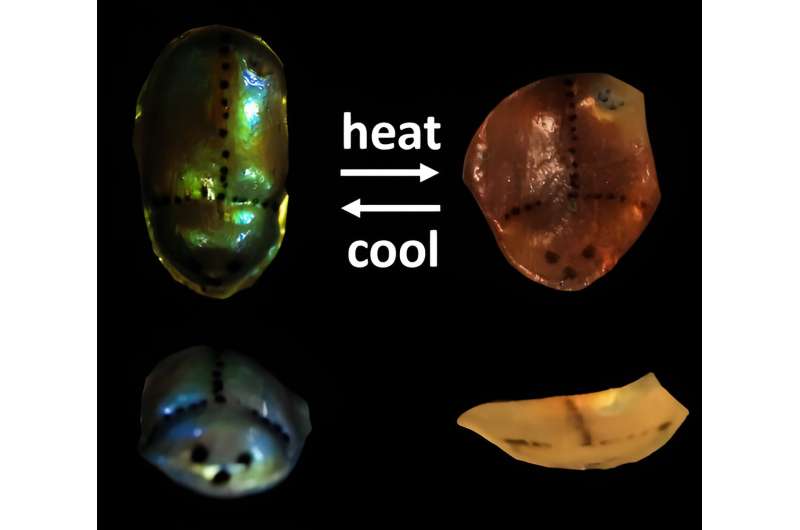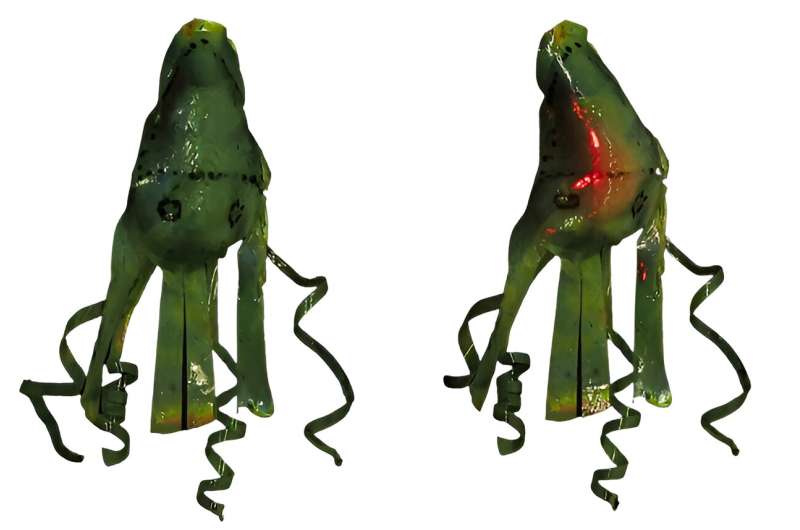This article has been reviewed according to Science X's editorial process and policies. Editors have highlighted the following attributes while ensuring the content's credibility:
fact-checked
trusted source
proofread
How to make color-changing 'Transformers' with polymers

Shape and color changing are key survival traits for many animals. Chameleons can change their body to hide from predators, to reflect their moods, or even to defend their territory, while some soft-bodied animal-like octopuses, squids, and cuttlefish can change both their color and shape to signal or camouflage.
Mimicking these capabilities using artificial polymer materials holds great potential in sensing, soft robotics, and the fashion and art industries. During her research, Ph.D. candidate Pei Zhang has realized some incredible color changing and shape morphing abilities in polymer materials.
As part of her Ph.D. research, Pei Zhang has developed versatile techniques for the fabrication of so-called liquid crystal elastomers, or LCEs for short, that exhibit both structural color changes and shape morphing properties similar to those seen in animals such as chameleons and octopuses.
"The animal kingdom is full of species capable of incredible abilities, in particular color and shape changing abilities," says Zhang. "Nature has shown us that color and shape changes are possible, so along with my colleagues, we developed different ways of replicating some of these abilities in polymer materials in the laboratory."
The LCEs developed by Zhang and her colleagues respond to various external stimuli such as changes in temperature, mechanical deformation through stretching, and changes in illumination.
Coatings
For her research, Zhang fabricated temperature responsive cholesteric LCE coatings and created structural color patterns in these coatings. The structural color originates from the periodical structure of the material, which reflects light. Pigment was not added to achieve this effect.
By placing another soft polymer carrier layer on top of the LCE coatings these cholesteric LCE thin films can be manually stretched. Upon stretching, these films then exhibit a color change from orange to blue.
The structural color of the pattern is prepared so that it reflects the near-infrared spectrum when the film is unstretched. This means that the structural color is not visible to the human eye. The material only reveals a pre-programmed pattern once it is stretched, whereby the reflected light wavelength shifts to the visible spectrum and the pattern then becomes visible. This process is known as mechanochromism.
This remarkable material holds great potential when applied as a mechanochromic sticker to detect the deformation of a substrate. For example, it offers direct visual feedback, making it suitable for applications in medical textiles to monitor the pressure applied on wounds as well as in ceilings and windows to monitor safety conditions in buildings.

Zhang also created a 3D-shaped "beetle" and a 3D-shaped "cuttlefish" that adjust their color from green to red when heated and their body shape when exposed to near-infrared light.
"Certain beetles exhibit the remarkable ability to alter their body colors, and I've demonstrated the feasibility of replicating this phenomenon in artificial polymer materials," says Zhang. "Through the creation of a 3D 'beetle' in the laboratory, I have shown that this color-changing capability can indeed be emulated. Notably, my 'beetle' surpasses the original concept by also possessing the capacity to modify its body shape. I further produced a 3D 'cuttlefish' to imitate both shape and color adaptations observed in various soft-bodied animals."
The methods used to fabricate structurally colored LCEs in Zhang's work form the basis for a versatile toolbox for the design and production of functional polymer materials.
Future directions
In terms of the future use of these materials, Zhang has a number of aspirations.
"Although the materials I have developed could be used in soft robotics and as strain sensors in smart textiles and holds significant promise, I would also like to see the psychological and aesthetic aspects of these materials being explored in the field of Human-Computer Interaction," says the researcher.
"This could add more visual interactivity to a product, which could improve the user experience and accessibility with a product. Moreover, incorporating these materials in the fashion industry is another exciting opportunity, such as crafting responsive jewelry that adapts its appearance based on the wearer's requirements."
More information: Structurally Colored Liquid Crystal Elastomer Actuators. research.tue.nl/en/publication … -elastomer-actuators
Provided by Eindhoven University of Technology





















